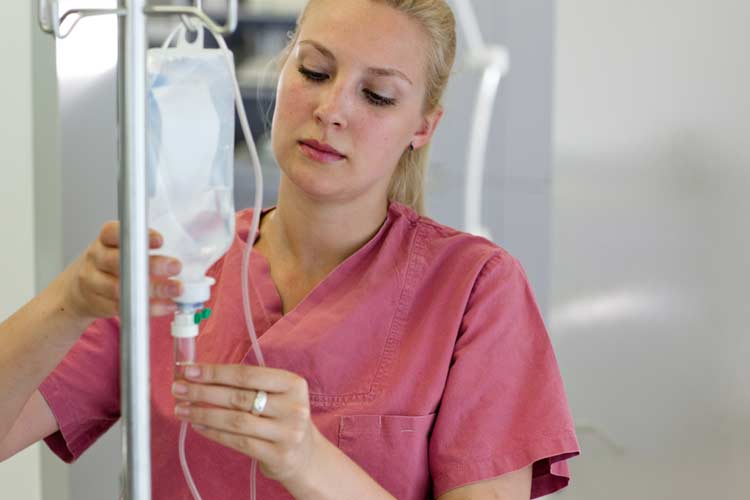Infusion therapy is the delivery of drugs directly into the bloodstream via a vein, usually located in the arm or hand. Also called Intravenous (IV) therapy, infusion therapy has become an effective strategy in treating and managing certain disease processes. Ambulatory infusion services allow the patient to move about the clinic in a safe and supervised manner without being confined to a chair or a bed for the duration of your treatment, usually taking about two hours for completion.1
What is IV Therapy?
Intravenous (IV) therapy is a widely used method for drug administration and is commonly known as drip therapy (related to the very recognizable bags of liquid in all the hospital scenes). Nurses and doctors are able to administer fluid directly into the veins using IV therapy. There are various types of fluid that can be administered, including a simple saline solution, a vitamin solution, or a solution containing necessary medications. As the fluid enters the bloodstream, its contents become available for use almost immediately. In addition, the body is easily able to take advantage of these contents because they can be directly accessed through the bloodstream (Carson et al. 2012). IV therapy is a relatively simple process that can be performed by nurses, but there are serious complications associated with it. Recently, there has been a discussion surrounding the necessity of hospitals in intravenous administration of medicine and other fluids.
Types of IV Therapy
The different types of fluid that nurses can administer through IV therapy serve a wide range of purposes in the medical community and often facilitate or complement treatment processes.
First, saline solution is a very simple yet important component of IV therapy, and is one of the most common solutions used in IV therapy (Fry 2015). Saline solution is a basic solution consisting only of water and salt, but it has been said that “there are few drugs as useful and as widely used in healthcare as normal saline” because it “is used to rehydrate patients with flu, and food poisoning, and Ebola, and countless dozens of other conditions…is used in dialysis and surgery” and is used to clean wounds (Fry 2015). Saline solution is used most often when a patient is ill and is either dehydrated or may become dehydrated. This is because saline solutions provide a direct supply of water, sodium, and chloride, all of which are important in the rehydration process. Since blood is made up of water, salts, cells, and proteins, the fluid being injected into the blood must be somewhat similar in composition. As a result, water must be supplemented with salt to make the saline solution – a solution isotonic to (having the same salt concentration as) the blood (Neville et al. 2005). IV administration of a saline solution eliminates the need for oral rehydration therapy, which can become difficult or impossible in certain situations. Intravenous rehydration therapy is necessary only in severe cases of dehydration, which often require a hospital visit (Huang et al. 2015).
Second, intravenous vitamin administration has recently become an important area of interest. The most common vitamins administered intravenously are vitamin C, vitamin D, and vitamin B12. Each of these vitamins are used for different medical reasons, but the governing idea is that intravenous vitamin injection can be a beneficial form of supplementary treatment. For example, research conducted on vitamin C administration has shown that it “may have preventative and therapeutic value against a number of pathologies”, including infections, rheumatoid arthritis, and most notably, cancer (Mikirova et al. 2013). Additionally, research has shown vitamin D to be helpful for dialysis patients and vitamin B12 for uremic and diabetic neuropathy (Andress 2001, Kuwabara et al. 1999)
Finally, medication administration is potentially one of the most impactful uses of IV therapy. As previously mentioned, medicines can become immediately and completely available via IV therapy. This can be quite beneficial in situations requiring immediate treatment such as severe infections. That being said, IV therapy can also be used to treat mild infections or to administer chemotherapy to cancer patients (Kasiakou et al. 2005, Carde et al. 1989). While some medical problems require IV therapy more often than others, IV therapy is extremely beneficial for the administration of medications to patients.
Statistics have shown that over 85% of patients in US hospitals were receiving IV therapy by the 1990s (Carson et al. 2012). Due to the aging baby boomer population, the number of patients requiring hospital care and potentially requiring IV therapy has likely increased since the 1990s. These growing patient numbers would result in a concurrent strain on resources or a necessary increase in the availability of resources. Moreover, these numbers, and thus the strain, are projected to continue to increase in the coming years.
While the need for IV therapy may not be able to be avoided in the near future, as it remains one of the better options for drug and fluid administration, other changes could be made to the current procedure in order to improve efficiency. One major change that has been considered recently is an increase in home IV therapy administration. Home IV therapy could significantly improve efficiency as well as reduce cost.
Typically, Infusion Therapy means that a drug is administered intravenously, but the term also may refer to situations where drugs are provided through other non-oral routes, such as:
- Intramuscular injections
- Epidural routes (into the membranes surrounding the spinal cord)
However, these are more passive methods of introducing the medicine into the patient. An external infusion pump is a medical device used to deliver fluids into a patient’s body in a controlled manner. There are many different types of infusion pumps, which are used for a variety of purposes and in a variety of environments.4 Infusion Pumps may be capable of delivering fluids in large or small amounts, and may be used to deliver nutrients or medications – such as insulin or other hormones, antibiotics, chemotherapy drugs, and pain relievers. Some infusion pumps are designed mainly for stationary use at a patient’s bedside. Others, called ambulatory infusion pumps, are designed to be portable or wearable. A number of commonly used infusion pumps are designed for specialized purposes.
These include:
Enteral Pump: A pump used to deliver liquid nutrients and medications to a patient’s digestive tract.
Patient-Controlled Analgesia (PCA) Pump: A pump used to deliver pain medication, which is equipped with a feature that allows patients to self-administer a controlled amount of medication, as needed.
Insulin Pump: A pump typically used to deliver insulin to patients with diabetes. Insulin pumps are frequently used in the home.
Infusion Pumps may be powered electrically or mechanically. Various pumps operate in different ways:
In a Syringe Pump, fluid is held in the reservoir of a syringe, and a moveable piston controls fluid delivery.
In an Elastomeric Pump, fluid is held in a stretchable balloon reservoir, and pressure from the elastic walls of the balloon drives fluid delivery.
In a Peristaltic Pump, a set of rollers pinches down on a length of flexible tubing, pushing fluid forward.
In a Multi-Channel Pump, fluids can be delivered from multiple reservoirs at multiple rates.
A “Smart Pump” is equipped with safety features, such as user-alerts that activate when there is a risk of an adverse drug interaction, or when the user sets the pump’s parameters outside of specified safety limits.
Uses for Infusion Therapy
Diseases requiring infusion therapy include infections that are unresponsive to oral antibiotics, cancer and cancer-related pain, dehydration, and gastrointestinal diseases or disorders which prevent normal functioning of the gastrointestinal system. Other conditions treated with specialty infusion therapies may include cancers, congestive heart failure, Crohn’s Disease, hemophilia, hepatitis, immune deficiencies, multiple sclerosis and rheumatoid arthritis. Below are the 10 most diagnoses for utilizing Infusion Therapy, and the % they make up of all Infusion Therapy patients:2
Diagnosis % of all Infusion Patients
Skin and Skin Structure Infection 9.2%
Bladder Diagnoses 6.4%
Infectious Arthritis 6.3%
Septicemia 5.9%
Pneumonia 4.0%
Complications from Surgical Procedures 3.4%
Congestive Heart Failure 3.1%
Bacterial Infections 3.0%
Fluid/Electrolyte Imbalance 3.0%
IV Therapy in Hospitals
Traditionally, all IV therapy has been carried out in hospitals and other healthcare settings. The benefits to receiving IV therapy in these places include access to professional care teams, immediate access to physicians in case of an emergency, and the support from other patients in similar situations. However IV therapy in hospitals can also be error-prone, expensive, and uncomfortable.
Hospitals are bustling places full of doctors and nurses who are willing and ready to assist with any problems that may arise during treatment. These people have been professionally trained and are available to patients around the clock for normal treatment as well as for emergencies. Many hospitals attract patients and encourage them to receive treatment there with the availability of these high-quality care teams. In the case of patients receiving IV therapy, teams of nurses are consistently available to administer and monitor the IV. Additionally, patients receiving IV therapy for any reason will likely be surrounded by other patients receiving similar treatment or who are in a similar situation. These patients are able to swap stories, share tips, and provide support for one another. Many personal accounts from current and former patients indicate that other patients are an integral part of their recovery.
On the other hand, one of the risks associated with hospital IV therapy is human error. The benefits to IV therapy can actually become problems if the therapy is not carried out correctly. While rapid administration and 100% bioavailability are some of the major upsides to IV therapy, these can be dangerous due to their irreversibility. If, for example, an inexperienced nurse makes a mistake in the dosage or the type of medication, nothing can be done to reverse the injection (Vijayakumar et al. 2014).
Aside from these potential nurse care problems in the hospital, hospital visits are often very expensive, especially if the IV therapy is not related to a condition that needs extremely specialized care. If the treatment requires only a simple saline solution or routine drug administration, it can be a burden, both financially and personally (due to the time commitment), for the patient to have to go to the hospital to receive care.
In addition to these already burdensome costs, hospital visits can be quite uncomfortable for patients. Hospitals are busy, loud, and public places with the presence of many other illnesses. Again, patients receiving simple IV therapy may be unhappy sacrificing their privacy and the comfort of their own home to receive treatment. This common feeling of discomfort is a hidden cost in the IV therapy treatment process.
These risks and downsides commonly associated with hospital IV therapy indicate that there some sort of change must be made. One consideration for improvement of IV therapy-based treatment is the creation of an IV therapy lead role in hospitals. A chief nurse in the hospital could take on this role to ensure that there exists proper training, proper incident reporting, and promotion of good practice. “Too often IV duties are given to junior staff who may lack the relevant experience or who have received little or no specific training on how to administer IV therapy” (Duffin 2014). While creation of an IV therapy lead role could reduce risks associated with hospital IV therapy, another alternative for safe and comfortable therapy is in-home patient care.
In-Home IV Therapy
Recently, some of the focus on IV therapy has been shifted from hospitals to homes. In-home IV therapy may be able to address some of the problems associated with hospital IV therapy, including complications, comfort, and cost.
With an increase in the desire of patients to have in-home IV therapy has come an increase in the number of nurses willing to provide that care. Many nurses are now specifically training to provide in-home IV therapy. “Infusion nurses will have special education, training and expertise in home or other alternate-site administration of drugs and biologics via infusion” and “will ensure proper patient education and training and monitor the care of the patient in the home” (National Home Infusion Association). This specialized nurse training may be able to reduce the risk of errors, complications, and infections that are common in busy hospitals with less specialized nurses. In-home nurses are able to focus their full attention first on training to provide a specific service and subsequently, the actual administration of that service. Additionally, with in-home IV therapy patients are able receive the supplies and administration all in the comfort of their own home. They can retain their privacy and their daily routine, and they won’t be exposed to other illnesses as they would in a hospital.
However, there is still a risk of errors, complications, and infections with in-home IV therapy. These risks may be elevated due to the relative proximity of physicians in a hospital versus in the home. In addition, although this specialized in-home care will likely still be expensive, it can be less expensive than hospital care, and the benefits of improved comfort and privacy can outweigh some of the cost. While there are risks and benefits to both hospital and in-home IV therapy, the decision of which type of care to take advantage of will ultimately rest with the patient. Thus, it is exciting that the patient now has two viable options: hospital care and in-home care.
Advantages and Disadvantages of Patients Using Infusion Therapy
The primary advantage Infusion Therapy has over traditional oral therapy is the immediate and therapeutic effect the introduction of the pharmaceutical product has immediately into the system, rather than the delayed effect it would have going through the digestive system. Other benefits include:5
- Control over the rate of administration and prolong the action of the product
- It is ideal for patients who have difficulty tolerating pharmaceutical products orally.
- Pain and irritation can be avoided that may be felt through oral ingestion
- Can be mobile in many situations depending on type of Infusion methodology
However, the disadvantages for the patient can be both physiological as well as psychological, as many individuals have an aversion to needles, let alone having one that will sit in a limb for 2 hours while a drug is being delivered intravenously. Other problems may include:6
- Phlebitis, or inflammation of the vein the drug is delivered into, either due to the need itself or the chemical being delivered
- Thrombophlebitis, or a clot formed in the vein due to the drug being delivered into the vein
- Extravasation is the leakage of intravenously (IV) infused potentially damaging medications into the extravascular tissue around the site of infusion.
- Microbial contamination and infection
- Circulatory overload, where insufficient control of administration may lead to speed shock
- Decrease blood pressure, tachycardia, or cyanosis
- Anaphylaxis or Allergic reactions, resulting in itching, rash, shortness of breath
While many of these risks can be greatly reduced or eliminated altogether, this requires training of the nurse administrating the process, and is an integral part of nurses professional practice in regards to Infusion Therapy.
What is the training for Infusion Therapy?
By definition, Infusion Nurses give patients medication and fluids via injection. They monitor patients, manage their tubing, maintain infusion catheters, and stay aware of potential drug complications. Infusion nurses can be found working in a multitude of hospitals, long-term care centers, clinics, and home health agencies. The aging of America, the advance of new medical technologies, and expected cost-saving initiatives required by the Patient Protection and Affordable Care Act are fueling demand for infusion nurses. Demand for infusion nurse services is expected to rise 26 percent by 2020, according to the U.S. Bureau of Labor Statistics.7
Infusion Nurses must first become registered nurses and must become licensed by passing the National Council Licensure Examination-Registered Nurse (NCLEX-RN). Infusion nurses also typically become certified through the Infusion Nurses Certification Corporation (INCC). Certification requirements include minimum experience and passing an examination. However, sitting for the test requires the following:8
- A minimum of 1,600 hours of experience in infusion therapy as an RN within the past two years.
- 1,600 hours of direct bedside care are not required.
- Nursing experience may be in the areas of nursing education, administration, research, or clinical practice within the infusion specialty.
Infusion Nurses must complete regular continuing education throughout their careers to maintain their licenses and certifications, keep their skills up to date, and stay abreast on the advancements in the field. The Infusion Nurses Society offers a variety of continuing education programs and annual conferences.
If you or a loved one needs Home Infusion Therapy, contact NurseRegistry at NurseRegistry.com/IV-Therapy or 650-462-1001.





